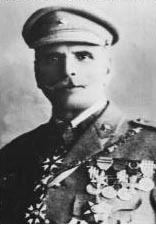Prime Minister Himself Spouse Mira Godinho (m. 1885) Political party Independent Party Independent politician | Name Manuel Oliveira Resigned July 9, 1926 Role Portuguese Politician | |
 | ||
Born January 14, 1863
Lisbon, Kingdom of Portugal ( 1863-01-14 ) Died December 17, 1929, Lisbon, Portugal Presidential term June 17, 1926 – July 9, 1926 Similar People Carlos I of Portugal, Philippe Petain, Julian Byng - 1st Viscount, Erich von Falkenhayn, Arthur Currie | ||
Succeeded by Antonio Oscar Carmona Succeeded by Antonio Oscar Carmona Preceded by Jose Mendes Cabecadas Preceded by Jose Mendes Cabecadas | ||
GOMES DA COSTA
Manuel de Oliveira Gomes da Costa, GOTE, GCA, GOA, commonly known as Manuel Gomes da Costa ([mɐnuˈɛɫ ˈɡomɨʒ dɐ ˈkɔʃtɐ]), or just Gomes da Costa (January 14, 1863 in Lisbon – December 17, 1929 in Lisbon), was a Portuguese army officer and politician, the tenth President of the Portuguese Republic and the second of the Ditadura Nacional.
Contents

Early life
Gomes da Costa was born as the son of Carlos Dias da Costa and Madalena de Oliveira; he grew up with two younger siblings, Lucrécia and Amália. He began his military career by studying at the Colégio Militar at age 10.
Military career
As a soldier, he stood out in colonial campaigns in the African and Indian colonies. After Portugal had entered the First World War (See: Portugal in the Great War) on the Allied side in early 1917, he commanded the Second Division of the Portuguese Expeditionary Corps. During the Battle of the Lys on April 9, 1918, the CEP lost 400 dead and around 6,500 prisoners, a third of its forces in the front line. Particularly Gomes da Costa's division was hit hard and was all but wiped out.
For his command in the war, he was made a general and a Grand Officer of the Military Order of Avis. Two years later, on 5 October 5, 1921 he received the Grand Cross of the Military Order of Avis.
Revolution
A convinced monarchist, Gomes da Costa had consorted with people of various political convictions. That, and his reputation as a soldier, led to his choice by right-wing revolutionaries to lead the 28 May 1926 coup d'état in Braga that overthrew the Portuguese First Republic, after General Alves Roçadas, their original choice, had died.
After the success of the revolution he did not assume power at first, entrusting the posts of President of the Republic and President of the Council of Ministers (Prime Minister) to José Mendes Cabeçadas, the leader of the revolution in Lisbon. Soon the coup leaders disliked the attitude of Mendes Cabeçadas, a choice of the previous president Bernardino Machado and still sympathetic towards the old republic. He was replaced by Gomes da Costa in both posts in a meeting in Sacavém on June 17, 1926. The new government was the first to include the later prime minister and dictator of Portugal, Antonio de Oliveira Salazar, as finance minister.
Overthrow and exile
Gomes da Costa's government lasted nearly as little as Cabeçadas's, because it was overthrown by a new coup on July 9 of the same year. This attempt was initiated by João José Sinel de Cordes and Óscar Carmona, after Gomes da Costa attempted to have Carmona removed as minister for foreign affairs.
Carmona, the new President of the Republic and of the Council of Ministers, used the pretext that Gomes da Costa was "unfit for office" and had him sent to exile in the Azores Islands. However, he also made him a Marshal of the Portuguese Army. In September 1927, he returned to mainland Portugal, already very ill; he died a few months later.
Personal life
On May 15, 1885 in Penamacor Gomes da Costa married Henriqueta Júlia de Mira Godinho (Lagos, Santa Maria, July 30, 1863 - February 22, 1936), by whom he had three children. Gomes da Costa was the father-in-law of Pedro Francisco Massano de Amorim, Governor of Gaza, Angola, Mozambique and India.
